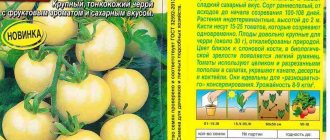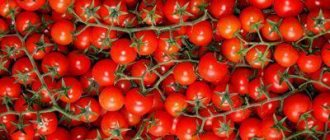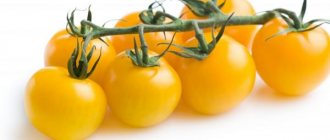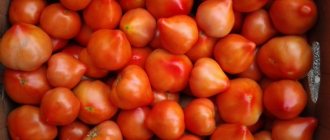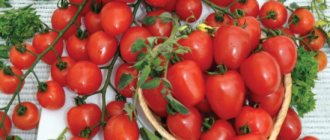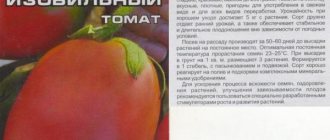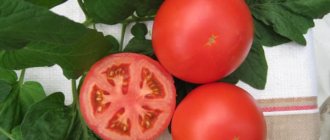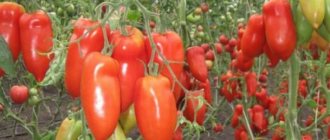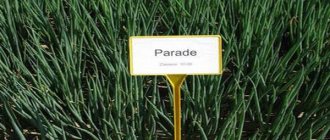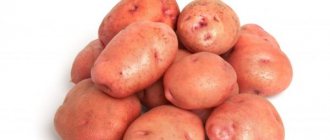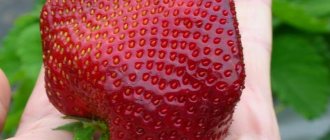Tomato "Little Red Riding Hood": description of the variety
| Variety name | Little Red Riding Hood |
| general description | Early ripening, determinate, high-yielding tomato variety |
| Originator | Germany |
| Ripening period | 90-100 days |
| Form | Flat-rounded, with slight ribbing at the stalk |
| Color | Red |
| Average weight of tomatoes | 60-70 grams |
| Application | Dining room |
| Productivity of the variety | 2 kg per bush |
| Features of cultivation | Standard agricultural technology |
| Disease resistance | Resistant to major nightshade diseases |
“Little Red Riding Hood” is an early-ripening, high-yielding variety.
The bush is determinate, the height of an adult plant does not exceed 70 cm. Read about indeterminate varieties here. The stems of the plants are strong and thick, in principle they do not require tying them to a support, but it is better to do this anyway, since there are a lot of fruits. The formation of green mass is moderate, the leaves are dark green and medium-sized. The fruits ripen in clusters of 3-5 pieces. The yield is good; up to 2 kg of selected tomatoes can be harvested from one bush.
You can compare the yield of the Red Riding Hood variety with other varieties in the table below:
| Variety name | Productivity |
| Little Red Riding Hood | 2 kg per bush |
| Russian size | 7-8 kg per square meter |
| King of Kings | 5 kg per bush |
| Long Keeper | 4-6 kg per bush |
| Grandma's gift | up to 6 kg per square meter |
| Podsinsky miracle | 5-6 kg per square meter |
| Brown sugar | 6-7 kg per square meter |
| American ribbed | 5.5 kg per bush |
| Rocket | 6.5 kg per square meter |
| De Barao the giant | 20-22 kg per bush |
Tomatoes “Little Red Riding Hood” are medium in size, weighing 60-70 g, smooth and neat. The shape is flat-rounded, with slight ribbing at the stalk. The color of ripe tomatoes is bright red-orange. The pulp is juicy, moderately dense, with a small number of seeds, the skin is thin and tender. The taste is pleasant, sweet, not watery, with a barely noticeable sourness.
You can compare the weight of the fruits of this variety with others in the table below:
| Variety name | Fruit weight |
| Little Red Riding Hood | 60-70 grams |
| Premier | 120-180 grams |
| King of the market | 300 grams |
| Polbig | 100-130 grams |
| Stolypin | 90-120 grams |
| Black bunch | 50-70 grams |
| Sweet bunch | 15-20 grams |
| Kostroma | 85-145 grams |
| Brawler | 100-180 grams |
| F1 President | 250-300 |
The high content of sugars, lycopene and valuable amino acids allows us to recommend the fruits for children's and dietary nutrition.
Tomato Rotkäppchen (Little Red Riding Hood) through the eyes of botanists
The variety belongs to standard crops, which, after the appearance of buds, stop growing.
Therefore, the tomato does not need such measures:
- bush garter;
- removal of stepsons;
- pruning
Typically compact bushes grow to a maximum of 40 cm in height. They consist of thick stems. They are decorated with fleshy green foliage.
During the flowering period, buds appear on the stems. Over time, they form round fruits. All of them are concentrated on the upper part of the bush and are collected in 6-7 pieces in a brush. The average weight of Rotkäppchen (Little Red Riding Hood) tomatoes ranges from 50 to 100 g.
Often the indicators are affected:
- the number of fruits on the bush;
- weather;
- methods of care.
The surface of the tomato has a glossy character. It is painted bright red. The interior is divided into two chambers. The pulp is medium in texture. The taste of tomato is sweet and sour.
In an unripe fruit, a spot appears in the area of the stalk, which disappears after full ripening.
Photo
See photo of the “Little Red Riding Hood” tomato below:
Agricultural technology varieties
It is better to start growing Red Riding Hood tomatoes by obtaining seedlings. Only if you are in the Southern region, then you can sow seeds directly into the ground. Sowing seeds for seedlings must begin in early March. If you purchased tomato seeds in a store, then there is no need to further process them before sowing. And if the seeds are collected from domestic fruits, then you will first need to carry out some procedures:
- soak in water and remove any seeds that float to the surface;
- Disinfect the remaining seeds in a solution of potassium permanganate;
- then rinse with water;
- you can soak it in a synthetic growth stimulator, and if you don’t want to use it, then fresh aloe juice will help: you need to leave the seeds in it for about a day.
Tomato red pear
The tomato loves light, fertile soil; it needs good absorption of moisture and air. You can buy ready-made soil mixture in the store or prepare it yourself. Making soil yourself is not difficult: you need to mix soil, coarse sand, humus, peat and mineral fertilizers. The container in which the tomatoes will be sown does not matter - it can be boxes, containers, cups, pots, cassettes.
Important! Do not compact the soil in the container too tightly - tomatoes love air and loose soil.
The seeds are 1 cm deep into the soil, sprinkled with dry soil on top, then the container must be covered with film and placed in a warm place until the first shoots appear. As soon as the first shoots appear, the film is removed, the seedlings are transferred to the brightest place in the room, while ensuring a temperature 5 degrees lower than it was before. It is possible to use lamps for additional illumination, since seedlings need at least 10 hours of light daily.
Based on experience, many gardeners recommend watering tomatoes no more often than their soil begins to dry out. Too wet soil provides favorable conditions for the development of fungal diseases, and too dry soil will weaken the growth of seedlings. At the stage of the appearance of the first two leaves, 2 weeks before transshipment, you need to start hardening the seedlings; to do this, they are taken outside: first for one hour, and then left longer and longer.
Watering tomatoes
It is recommended to plant seedlings in an open bed when the threat of frost has passed and the soil has warmed up. The best place to grow Red Riding Hood tomatoes in a personal plot is the area where cabbage, cucumbers, zucchini, greens, carrots and legumes grew last year.
Attention! It is not recommended to plant tomato seedlings in places where tomatoes, potatoes, peppers and eggplants grew last year.
Before planting seedlings, the soil must be prepared: it must be dug up, humus, ash or mineral fertilizer must be added. It is recommended to plant tomatoes at a distance of 50 cm between rows and 30 cm in rows. The Red Riding Hood tomato requires timely watering, loosening, fertilizing and, of course, harvesting. Since the bushes of this variety are low-growing, there is no need to shape them; they can be tied up as needed and as the number of fruits on the branch increases.
As fertilizers, the Red Riding Hood variety tomato prefers liquid organic mineral mixtures, iodine, infusion of chicken manure or mullein. At least 20 days should pass between feedings. 2 weeks before harvesting, the final feeding of the plants should be done.
For tomatoes, it is very important to loosen the soil, it is better to do this after each watering, this way you can ensure access of oxygen to the roots. Loosening is carried out no deeper than 5 cm, so as not to affect the root system of the plant.
Loosening the soil
Origin and application
Tomatoes “Little Red Riding Hood” are a variety of German selection, zoned for areas with temperate climates. It is recommended to grow in a greenhouse or hothouse; in open ground the yield is significantly lower. Plants tolerate short-term drops in temperature.
Miniature bushes can be planted in flowerpots and containers for placement on balconies, verandas, and window sills. The yield is good, the collected fruits can be stored and transported for a long time.
“Little Red Riding Hood” are tomatoes that can be picked green and ripen quickly at room temperature.
Tomatoes of the “Little Red Riding Hood” variety are considered salad tomatoes; they are delicious fresh and suitable for making soups, sauces, purees, and juices. Ripe fruits can be used to make homemade ketchups, pastes and other products. The variety is not suitable for whole-fruit canning; the thin skin is prone to cracking.
general characteristics
The Red Riding Hood tomato variety has a second name - Rotkäppchen, it was invented by German breeders. Germany is where the variety was bred.
It was first brought to Russia at the beginning of 2010, and the very next year it was registered in Rosreestr and distributed throughout all regions of the country.
Main characteristics of the variety
The Red Riding Hood variety is an early-ripening determinate variety; the tomato is characterized by high yield and unpretentiousness. Suitable for planting in a greenhouse, as well as in open ground.
Due to its early ripeness, they prefer to grow the crop in heated greenhouses or film tunnels. If you follow the basics of care, the harvest can already be harvested in mid-May.
():
In greenhouses, such determinant early ripening varieties are used for growing crops in 2 rotations. Bushes that bear fruit are removed, and another vegetable crop is sown or planted in their place.
Thanks to their compactness, gracefulness and unpretentiousness, tomatoes can often be found on balconies, in apartments, on window sills or loggias.
By providing additional lighting and creating optimal conditions for development, the crop will bear fruit throughout the summer season.
Description of the plant
The bush is compact, low. The stems are strong, thick, durable, moderately leafy.
According to the description, an adult plant grows up to 40 cm in height. The bushes do not require pinching or pruning.
As for tying, gardeners have different opinions on this matter.
- Many people believe that gartering is necessary for bushes, because a large number of fruits ripen on one plant. This may cause injury.
- Other gardeners are sure that there is no need to tie up the bushes, because the height of the plant is small and the branches are quite strong.
Still, it’s better to tie up tomatoes – once, at the level of the middle of the bush. Such protection will be quite enough to protect the plant from injury and maintain its spectacular appearance.
():
Staking small compact plants brings more inconvenience to the tomatoes themselves than benefit. They have short internodes and closely spaced leaves. When tied up, such bushes are poorly ventilated and less exposed to sunlight, which means there are always prerequisites for the development of fungal diseases.
Description of fruits
Red Riding Hood tomatoes are medium in size, weighing up to 100 g. The shoots form a “cap” on which the fruits ripen. On one brush it grows up to 6-7 pieces.
The shape is round, the skin is smooth, the structure is medium density. At the ripe stage, the fruits take on a juicy red color.
It is allowed to remove green fruits. Subsequently, they quickly ripen in room conditions.
Productivity
With proper cultivation of tomatoes and compliance with all the basics of agricultural technology, the yield is up to 5 kg per bush. From 1 sq. m. of plantings receive, on average, up to 15-20 kg.
Advantages and disadvantages
Among the main advantages of the variety:
- high taste qualities of fruits;
- good yield;
- disease resistance;
- compact bushes do not take up much space in the garden bed;
- cold resistance;
- no bush formation required.
No disadvantages were noticed in the variety. To increase productivity, abundant fertilizing and moderate watering are recommended.
Caring for the hybrid Red Krasno F1
We recommend reading our other articles
- How to treat currants against pests and diseases?
- How to feed and maintain the Kuban geese breed
- Przewalski's horse
- How to grow garden strawberries
If you adhere to basic care standards, the Red Red F1 tomato will delight you with productivity.
It is necessary to grow Red Krasno F1 tomatoes on a trellis or other good support
- It is necessary to grow Red Krasno F1 tomatoes on a trellis or other good support. The bushes grow tall, so you can get by with small pegs only at an early stage of development.
- Watering is carried out once every 2-3 days, depending on how quickly the soil dries out.
- In order for the root system to develop normally, you need to loosen the soil after each watering, as soon as the water is absorbed.
- Weeds are removed as they appear. They need to be pulled out by the roots so they don't sprout again. This is done before flowers appear on them, and even more so – seeds!
- In order for tomatoes to develop well, it is necessary to carry out formation and pinching once a week. Always leave the main pagon (can be formed into 1-2 stems), the rest are removed before they grow 4-5 cm!
Important! Stepchildren of tomatoes always break them off with their hands. This is safer and less traumatic for the plant than cutting with a knife or garden shears
- For high yields, fertilizing is carried out 2 times a month. Before flowering, the bushes are fertilized with urea, nitroammophos or complex compounds, and after flowering and when fruits appear, phosphorus-potassium mixtures must be added.
- Mulching allows you to reduce the number of waterings, fertilizing, and also keep the area clean from weeds. You can mulch tomatoes with hay or straw. The mulch layer should be up to 10 cm.
- For the prevention and treatment of bushes from diseases, use Fitosporin, 1% Bordeaux mixture or 1% solution of potassium permanganate. Among the folk remedies, infusions of tar, soap, wormwood poison, and celandine help. Usually these funds are more than enough, since the Red Red F1 tomato has a good immune system.
The demanding care requirements of the Red Krasno F1 tomato are compensated by high and long-lasting productivity. The fruits are very tasty, marketable and suitable for transportation, which is why this hybrid is in demand among professional gardeners.
Features of cultivation
Like most tomatoes, it is more convenient to grow the “Little Red Riding Hood” tomato variety in seedlings. The best germination is achieved by seeds collected 2-3 years ago. Before planting, they can be soaked in a growth stimulator. Some gardeners prefer freshly squeezed aloe juice, which perfectly strengthens the immunity of plants.
To prevent diseases, seeds can be disinfected in a pink solution of potassium permanganate, and then rinsed with clean water and dried. Tomatoes of the “Little Red Riding Hood” variety are sown in the second half of March or early April.
For seedlings, you need light nutritious soil from a mixture of garden or turf soil with humus. A little washed river sand is added to the substrate; a portion of wood ash or superphosphate will not hurt either. Seedlings are sown in containers or peat pots, the seeds are planted with a depth of 1-1.5 cm. When using individual pots, you can do without subsequent picking.
For successful germination, seedlings need a temperature of 23 to 25 degrees. After emergence of seedlings, it is lowered to 16-17 degrees for 5-7 days. Then the temperature is raised to normal room temperature.
This procedure strengthens the plants and prevents them from starting to grow ahead of time. Water the seedlings moderately with warm, settled water using a watering can or spray bottle.
When the first pair of true leaves unfold on the seedlings, they are picked out into separate pots. It is recommended to feed young tomatoes with liquid complex fertilizer. A week before planting, they begin to harden them by taking them out into the fresh air.
Transplantation into the greenhouse begins in the second half of May. The soil is thoroughly loosened and mixed with humus. Read also about the types of soil and soil for planting tomatoes in greenhouses. For 1 sq. m place 3-4 bushes. There is no need to tie them up or pinched them; for better insolation, it is recommended to remove excess leaves.
Watering is infrequent, but abundant, as the top layer of soil dries. During the season, plants are fed 3-4 times with mineral fertilizers. Before flowering begins, nitrogen-based complexes are introduced; after the ovaries form, it is worth feeding the tomatoes with magnesium sulfate.
Foliar feeding is useful, for example, copious spraying with an aqueous solution of superphosphate. Mineral fertilizers can be alternated with organic matter: diluted mullein or bird droppings.
Nuances of cultivation
Since tomatoes of this variety ripen very quickly, in the southern regions the seeds can be sown directly into the ground or, in extreme cases, under film covers. Well, in the middle zone, and even more so in the north, Red Riding Hood tomatoes are grown only with the help of seedlings.
Before sowing, seeds are traditionally tested for germination in salted water. The floating seeds are removed, and those that have settled to the bottom are washed thoroughly in running water to remove traces of salt and sown in prepared containers. At temperatures above +18°C, you can expect the first shoots already on the 5-6th day. In the first week after germination, it is important to reduce the temperature of tomato seedlings by 5 degrees or at least ensure a significant difference between day and night temperatures. This will contribute to additional hardening of the seedlings and the formation of a strong root system. After breaking through the first true tomato leaf, the seedlings should be pricked. Before planting in the ground, you can feed it 1-2 times, but the main thing at this stage is to provide it with enough light and water.
Attention! Considering the compactness of the bushes of this tomato variety, they can be planted quite densely in the ground. Up to 5 plants of this variety can fit per square meter.
The first inflorescence should appear above the fifth or sixth leaf. During flowering, it is advisable to spray tomatoes with boron and iodine for successful pollination and the prevention of certain diseases. Red Riding Hood tomatoes are resistant to many diseases, so they will not require unnecessary chemical treatments against diseases.
Tomato ripening occurs relatively smoothly.
Diseases and pests
The variety is resistant to the main diseases of tomatoes in greenhouses - Alternaria, Fusarium, Verticillium, so control measures are most often not needed, but preventive measures will not hurt. Before planting seeds, the soil is calcined in the oven or spilled with a hot solution of potassium permanganate. In the greenhouse, the top layer of soil is replaced annually, and mulching is also used.
You cannot plant tomatoes in beds that are occupied by other nightshades: potatoes, sweet peppers, eggplants.
Ideal predecessors of tomatoes: legumes, carrots, lettuce, cabbage, herbs. Crop rotation will protect tomatoes from diseases and significantly increase yields. Preventive spraying of plantings with phytosporin or other non-toxic biological preparation is recommended.
Early ripening varieties are rarely affected by late blight. But in the event of an epidemic, copper-containing preparations, which are generously applied to the plantings, will help. There are other methods of protection, as well as varieties that do not suffer from late blight. Frequent ventilation of the greenhouse, timely removal of weeds, and mulching the soil with peat, humus or straw can help prevent fungal diseases.
In a greenhouse, tomatoes are threatened by aphids, spider mites, whiteflies and thrips. You can get rid of flying insects using industrial insecticides; plants are sprayed with them 2-3 times at intervals of several days.
After fruit set, toxic drugs are replaced with herbal ones: a decoction of celandine, yarrow, chamomile or onion peel. You can destroy slugs with an aqueous solution of ammonia; the aphids are washed off with warm soapy water.
Having read the description of the “Little Red Riding Hood” tomato, we can say that this is an interesting and original variety
Growing seedlings
It is recommended to sow seeds for seedlings 60 days before the intended planting in the ground. They must first be disinfected.
To do this, you can soak the seeds in a weak solution of potassium permanganate for 3 hours. Additionally, some gardeners keep them in a growth stimulator (can be purchased at a specialty store). Such processing allows you to obtain healthy seedlings, which in the future will give a rich and high-quality harvest.
The ideal soil for tomatoes is a mixture of turf and humus. Additionally, you can add a small amount of river sand. A small amount of fine wood ash is suitable as a nutrient mixture.
Seedlings are sown in special containers-pots (peat cups or containers) to a depth of 1.5 cm.
Picking is carried out at the stage of appearance of the second true leaf. When growing seedlings in individual containers, this procedure is not required.
Description of optimal conditions:
- before sprouts germinate, the temperature in the room must be at least 24°;
- after the emergence of young shoots –18°;
- after 7 days, the seedlings are moved to a room with a temperature of 22°.
Transfer
Planting seedlings in the ground is carried out according to a certain scheme:
- no more than 5-6 bushes should be located per 1 m²;
- recommended pattern – 70x30 cm.
Little Red Riding Hood
Tomato varietal Red Riding Hood. Brief overview, description of the characteristics of Krasnaya Shapochka
Tomato Red Riding Hood
